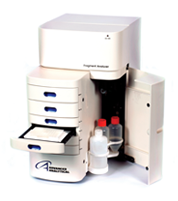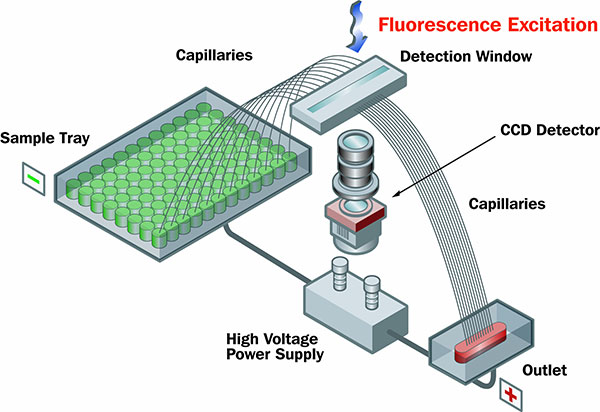
![]() 유전자분석장비
유전자분석장비
Fragment Analyzer™
Fragment Analyzer™

Introducing one powerful instrument to cover the full spectrum of DNA, gDNA and RNA quality control. Fragment Analyzer™ does everything from high-resolution analysis to fast DNA separations, across the widest separation range.
Fragment Analyzer™
Automated Capillary Electrophoresis System
The Fragment Analyzer™ Automated CE System is a fluorescence-based capillary electrophoresis instrument for both sizing and quantifying nucleic acids (DNA and RNA). By using a sensitive intercalating dye coupled with a powerful LED light source, Fragment Analyzer™ Automated CE System obviates the need for fluorescent labeled primers and can be used to separate dsDNA fragments and RNA (mRNA and total RNA). The Fragment Analyzer™ Automated CE System is the most flexible system on the market today, with the greatest sensitivity, the highest separation resolution over a wide range, the widest dynamic range and the fastest separation times.
This instrument comes available for customers who wish to run either 12 samples or 96 samples at a time.
Currently kits are available to:
• quantify and qualify NGS fragments.
• quantify and qualify RNA.
• quantify and qualify genomic DNA.
• do Mutation Detection, also known as TILLiNG, a reverse genetics technique.
The application kits help laboratories to streamline workflow and avoid bottlenecks typically found with competitive lab-on-a-chip methods. Gels formulated to provide high resolution separation are also available for general fragment analysis, such as SSR/microsatellites, small and large PCR fragments (amplicons) and resolve fragments sized between 10 bp and 40,000 bp with resolution down to 2bp.
Each and every kit is performance-tested prior to shipment to ensure quality, accuracy and ease of use for customers. Most kits require a single pipetting step before placement of the sample plate onto the instrument.
An analytical software package, PROSize™, greatly reduces post-separation analysis time. Put them all together — the instrument itself, the QC-tested application kits, and the analytical software — and the combination makes the Fragment Analyzer™ Automated CE System a powerful package for reducing labor and improving lab workflow and throughput.
Contact us today and request an instrument for your free one day trial.
Parallel Capillary Electrophoresis: De스크립트ion of Technology
Advanced Analytical's parallel capillary electrophoresis (CE) technology enables electro-driven analytical separations of DNA and RNA with on-line, simultaneous LED-based fluorescent detection. •exchangeable capillary array assembly.
•fixed optical detection platform.
•high-voltage power supply.
•fluid pumping system.
•automatic tray positioning system.
Customized software is tailored for specific applications and provides instrument control, data acquisition, and data analysis. End-users may view the CE separations as electropherograms, or as digital gel images.
The instrument is designed to handle either a 12 capillary array which can access all wells of a 96-well plate, 12 samples at a time or a 96 capillary array, able to sample all positions in one injection. Standard capillary dimensions are 50μm inner diameter (i.d.) and 200μm outer diameter (o.d.).
Anyone who was worked with agarose or acrylamide gel electrophoresis knows about the trade- off between speed vs. resolution. If you want high resolution; you use a long box. If you want answers quickly, you use a short box. Likewise with the Fragment Analyzer™ Automated CE System: various capillary lengths can be used, depending on the application, required resolution and desired speed of analysis. Longer arrays provide resolution down to 2 bp for fragments under 300 bp in length. Shorter arrays still provide good resolution with run times as fast as 15 minutes.
The inlet side of the capillary array is arranged in an 8 x 12 format with electrodes placed side-by-side with each capillary, allowing for direct injection via vacuum or voltage from standard 96-well plates. The capillaries are aligned in parallel in the detection window, which is positioned between the LED light source and the detector assembly. The outlets of the capillaries are bundled to a common reservoir where they are connected to a ground. The capillary arrays are modular in nature and a new capillary array can be exchanged in less than five minutes.
Room temperature air is circulated around the capilla
ries to modulate the temperature during the CE separation. Technology Schematic (12 capillary Version shown)

Specifications
Maximum Sample Throughput (12 capillary array): •12 samples in 30 minutes for NGS fragments
• 12 samples in 45 minutes for RNA
• 12 samples in 12 minutes for DNA fragments
Maximum Sample Throughput (96 capillary array): •96 samples in 60 minutes for NGS fragments
• 96 samples in 70 minutes for RNA
• 96 samples in 20 minutes for DNA fragments
Sample per run :
• Up to 96
Maximum unattended sample capacity :
• 288 samples
Minimum sample volume :
• 20 µl; Typically 2µl of sample is required for dilution
Gel sizing ranges :
• NGS; 35 - 6,000 bp
• Total RNA and mRNA; 19 - 6,000 base
• Genomic DNA
Resolution :
• Gel dependent, as low as 2 bp
Sizing accuracy :
• Typically 5% or better
Sensitivity :
• <100 pg/µl for smears
Light source power :
• One 1,000mW LED
LED wavelength :
• 470nm
Emission collection devise :
• CCD detector
Software :
• Fragment Analyzer™
system software and PROSize™ data analysis softwareData export format: •Microsoft© Excel spreadsheet
Environmental conditions :
• Indoor use, normal laboratory environment 20 - 23°C
Relative humidity range :
• <80% (non-condensing)
Electrical :
• 100 - 200 VAC; 50 - 60 Hz; 15A
Instrument dimensions :
• Fully configured requires 61 cm H x 35 cm W x 51 cm D (24 x 14 x 20 in)
Instrument weight :
• 38.5Kgs (85lbs)








 시약 및 소모품
시약 및 소모품
